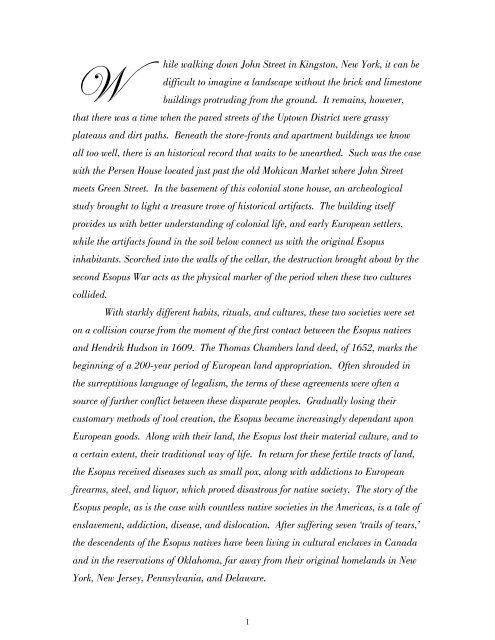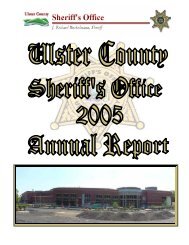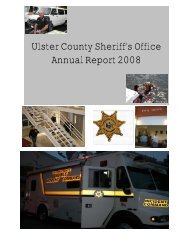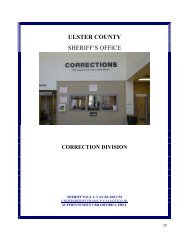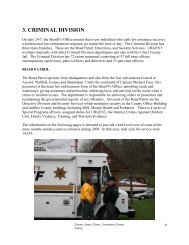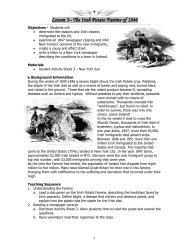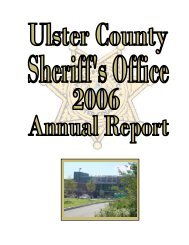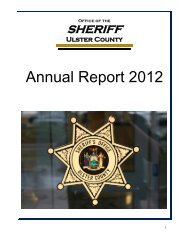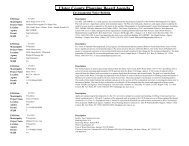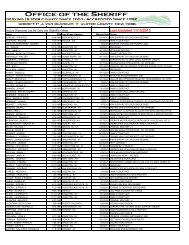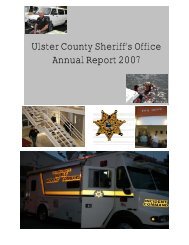The Story of the Esopus Natives and Their Encounter with European ...
The Story of the Esopus Natives and Their Encounter with European ...
The Story of the Esopus Natives and Their Encounter with European ...
You also want an ePaper? Increase the reach of your titles
YUMPU automatically turns print PDFs into web optimized ePapers that Google loves.
j<br />
hile walking down John Street in Kingston, New York, it can be<br />
difficult to imagine a l<strong>and</strong>scape <strong>with</strong>out <strong>the</strong> brick <strong>and</strong> limestone<br />
buildings protruding from <strong>the</strong> ground. It remains, however,<br />
that <strong>the</strong>re was a time when <strong>the</strong> paved streets <strong>of</strong> <strong>the</strong> Uptown District were grassy<br />
plateaus <strong>and</strong> dirt paths. Beneath <strong>the</strong> store-fronts <strong>and</strong> apartment buildings we know<br />
all too well, <strong>the</strong>re is an historical record that waits to be unear<strong>the</strong>d. Such was <strong>the</strong> case<br />
<strong>with</strong> <strong>the</strong> Persen House located just past <strong>the</strong> old Mohican Market where John Street<br />
meets Green Street. In <strong>the</strong> basement <strong>of</strong> this colonial stone house, an archeological<br />
study brought to light a treasure trove <strong>of</strong> historical artifacts. <strong>The</strong> building itself<br />
provides us <strong>with</strong> better underst<strong>and</strong>ing <strong>of</strong> colonial life, <strong>and</strong> early <strong>European</strong> settlers,<br />
while <strong>the</strong> artifacts found in <strong>the</strong> soil below connect us <strong>with</strong> <strong>the</strong> original <strong>Esopus</strong><br />
inhabitants. Scorched into <strong>the</strong> walls <strong>of</strong> <strong>the</strong> cellar, <strong>the</strong> destruction brought about by <strong>the</strong><br />
second <strong>Esopus</strong> War acts as <strong>the</strong> physical marker <strong>of</strong> <strong>the</strong> period when <strong>the</strong>se two cultures<br />
collided.<br />
With starkly different habits, rituals, <strong>and</strong> cultures, <strong>the</strong>se two societies were set<br />
on a collision course from <strong>the</strong> moment <strong>of</strong> <strong>the</strong> first contact between <strong>the</strong> <strong>Esopus</strong> natives<br />
<strong>and</strong> Hendrik Hudson in 1609. <strong>The</strong> Thomas Chambers l<strong>and</strong> deed, <strong>of</strong> 1652, marks <strong>the</strong><br />
beginning <strong>of</strong> a 200-year period <strong>of</strong> <strong>European</strong> l<strong>and</strong> appropriation. Often shrouded in<br />
<strong>the</strong> surreptitious language <strong>of</strong> legalism, <strong>the</strong> terms <strong>of</strong> <strong>the</strong>se agreements were <strong>of</strong>ten a<br />
source <strong>of</strong> fur<strong>the</strong>r conflict between <strong>the</strong>se disparate peoples. Gradually losing <strong>the</strong>ir<br />
customary methods <strong>of</strong> tool creation, <strong>the</strong> <strong>Esopus</strong> became increasingly dependant upon<br />
<strong>European</strong> goods. Along <strong>with</strong> <strong>the</strong>ir l<strong>and</strong>, <strong>the</strong> <strong>Esopus</strong> lost <strong>the</strong>ir material culture, <strong>and</strong> to<br />
a certain extent, <strong>the</strong>ir traditional way <strong>of</strong> life. In return for <strong>the</strong>se fertile tracts <strong>of</strong> l<strong>and</strong>,<br />
<strong>the</strong> <strong>Esopus</strong> received diseases such as small pox, along <strong>with</strong> addictions to <strong>European</strong><br />
firearms, steel, <strong>and</strong> liquor, which proved disastrous for native society. <strong>The</strong> story <strong>of</strong> <strong>the</strong><br />
<strong>Esopus</strong> people, as is <strong>the</strong> case <strong>with</strong> countless native societies in <strong>the</strong> Americas, is a tale <strong>of</strong><br />
enslavement, addiction, disease, <strong>and</strong> dislocation. After suffering seven ‘trails <strong>of</strong> tears,’<br />
<strong>the</strong> descendents <strong>of</strong> <strong>the</strong> <strong>Esopus</strong> natives have been living in cultural enclaves in Canada<br />
<strong>and</strong> in <strong>the</strong> reservations <strong>of</strong> Oklahoma, far away from <strong>the</strong>ir original homel<strong>and</strong>s in New<br />
York, New Jersey, Pennsylvania, <strong>and</strong> Delaware.<br />
I


